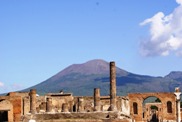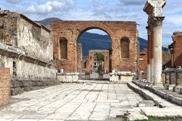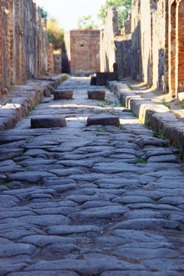
HERCULANEUM AND POMPEII GUIDED TOUR WITH A REAL ARCHAEOLOGIST
Details
HERCULANEUM AND POMPEII GUIDED TOUR WITH A REAL ARCHAEOLOGIST:
DURATION: |
7/8 hours | |
PRICE: |
According to the number of the participants | |
AVAILABILITY: | All-year-round | |
| English-speaking driver with an air-conditioned Mercedes (or similar make) at your disposal for 7/8 hours A private English-speaking real archaeologist in the excavations of Pompeii and Herculaneum ENTRANCE FEES NOT INCLUDED | |
Itinerary Details are listed below:
TOUR SCHEDULE OF POMPEII & HERCULANEUM
|
| Meeting with our English-speaking driver and his Mercedes car (with air-conditioning) by Your hotel or the cruise ship |
| Arrival to Herculaneum ruins and private visit (2 hours) of the site with a real English-speaking archaeologist |
| Transfer (with the same archaeologist) to the excavations of Pompeii |
| 1 hour of free time in Pompeii for lunch - lunch not included |
| 2 hour visit of Pompeii with the same English-speaking archaeologist |
| Back to Your hotel or to the cruise ship |
The famous eruption of Mt Vesuvius on 24 August of 79 AD caused the destruction of flourishing Roman towns of the Vesuvian area, such as Pompeii, Herculaneum, Stabiae and Oplontis. We have news of those terrible events through the writings by Pliny the Younger in the two letters sent to Tacitus in which he tells the dramatic death of his uncle, Pliny the Elder, author of the Naturalis Historia, who died in an attempt to bring relief to the population affected by immense calamity.
The excavations of Herculaneum cover an area of about 5 hectares that correspond to about a quarter of the alleged overall surface of the ancient city, still largely buried below the modern Herculaneum. The particular details of the burial of Herculaneum, which was submerged by streams of pyroclastic material solidified for an average height of about 20 meters, determined a conservation phenomenon which is absolutely original. Without comparisons to Pompeii, Herculaneum has given us back charred wooden structural and architectural parts of the buildings, preserved even in their fragility due to the lack of oxygen. The large part of the archaeological area that can be visited consists of private houses of different types, more or less deeply renovated during the Imperial age: they boast levels of luxury exhibition which is on average higher than that of the contemporary Pompeian houses. There are also some public and sacred buildings, such as the sumptuous Public Baths, the Sede degli Augustali (Collegial shrine of the Augustales) and the Sacred area dedicated to Venus. The conservation of this huge patrimony requires immense resources that has never been possible to find. Since 2001, however, the Herculaneum Conservation Project (HCP) is underway, a program of conservation, research and development of the Herculaneum site shared by the Superintendency and the Packard Humanities Institute, an American philanthropic foundation. The aim is to support and to strengthen the Superintendency's effort in the works and conservation activities necessary to safeguard this heritage of Humanity and to transmit it to future generations, but also to broaden scientific knowledge and promote the public's interest in the ancient city.
During the same 79 AD eruption of Mount Vesuvius, unlike Herculaneum Pompeii was buried by a thick layer of ash and pumice stones. This Roman town, considered as Unesco heritage site, is one of the most visited archaeological destinations in the world: last year 3.5 million visitors explored this incredible city of antiquity. Impossible to remain indifferent to the ruins of this ancient town. It is also the testimony of a past that lives in its splendor; it is the photograph of an ancient Roman city that still, despite the passing of time, arouses fascination because Pompeii is the only case in the world where it is still possible to find an entire Roman city two thousand years later. Pompeii, with its numerous material testimonies, represents perfectly a typical ancient Roman town: the Forum, the Basilica (Court of Justice), the baths, the theater, the amphitheater, the houses, the shops give a great idea of the political, economic and religious organization of Roman society. Today with the Great Pompeii Project, generous funds from the European Community have been allowing the progressive recovery of this splendid jewel of Roman archeology for a couple of years.
WHY A REAL ARCHAEOLOGIST AS YOUR PRIVATE GUIDE TO HERCULANEUM AND POMPEII ?
The Roman cities of Pompeii and Herculaneum are in an extraordinary state of conservation and deserve a visit worthy of their value. In the company of a real archaeologist, (two hours for each archaeological site) you will be able to appreciate the most evocative places of these mysterious Roman towns. What was the urban planning, the interiors of the houses, the daily life with all the furnishings, the objects in common use: in other words, what constituted the essence of a Roman city, and it can only be found in Pompeii and in Herculaneum.
THIS TOUR WILL OPERATE RAIN OR SHINE, SO BE PREPARED FOR ALL WEATHER CONDITIONS.
THIS IS A GUIDED TOUR WITH PRICES BASED ON THE NUMBER OF PEOPLE TRAVELLING IN YOUR PARTY!
VISIT POMPEII RUINS WITH THE AUDIO SYSTEMS









